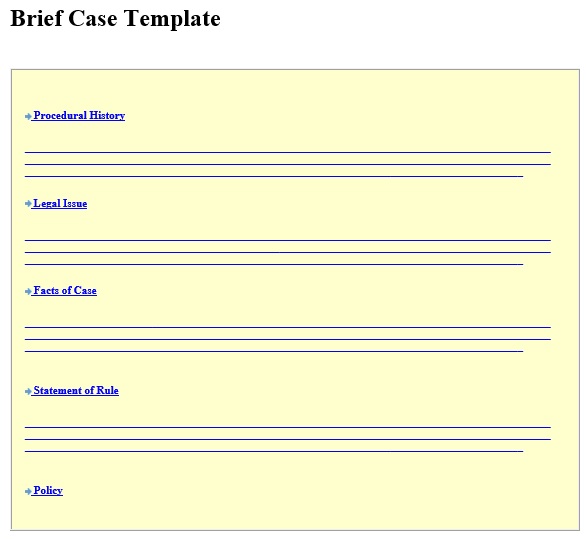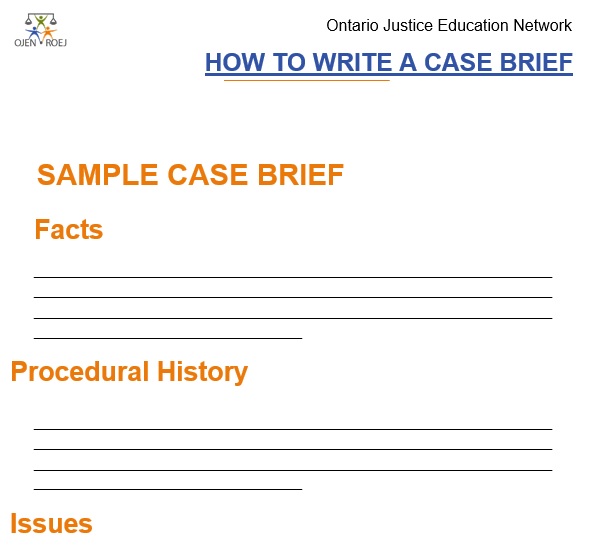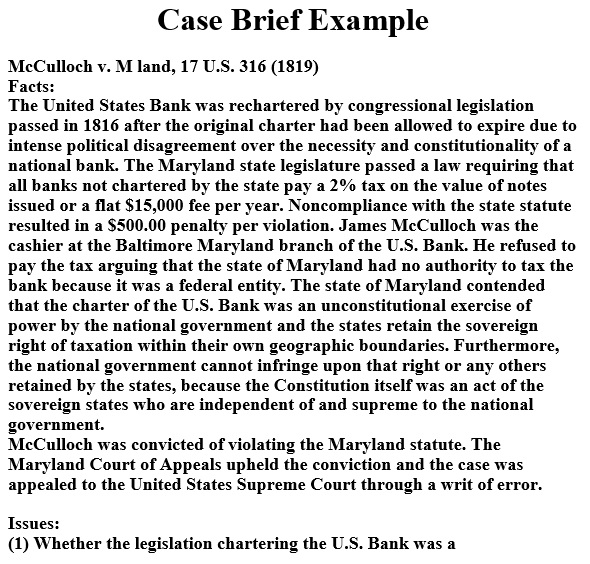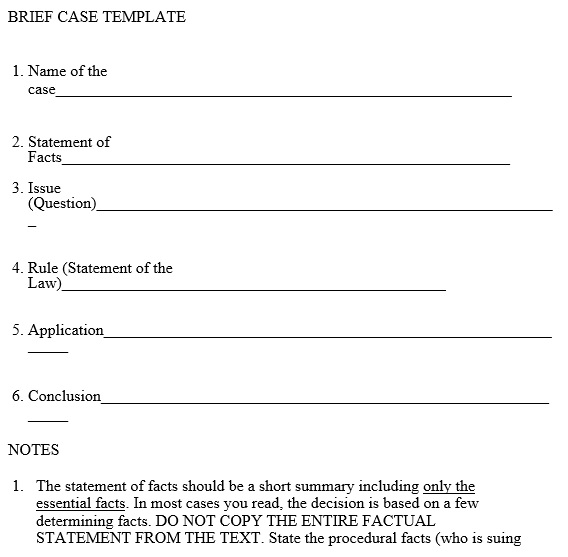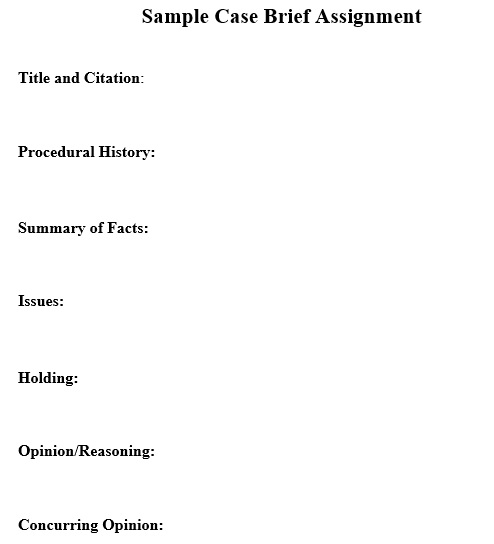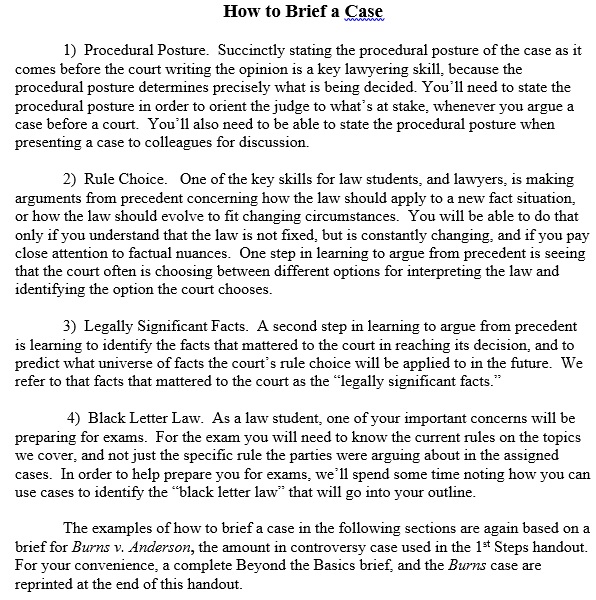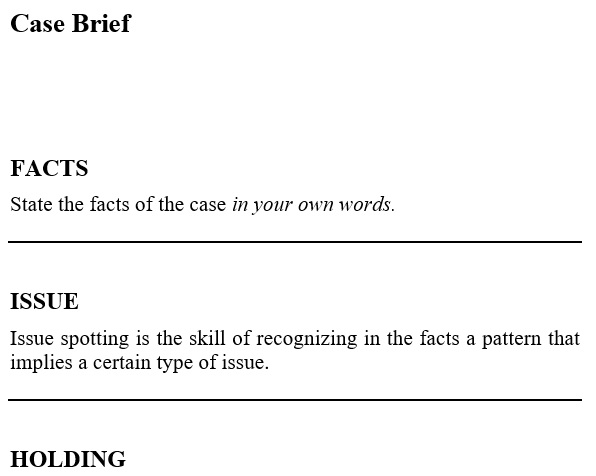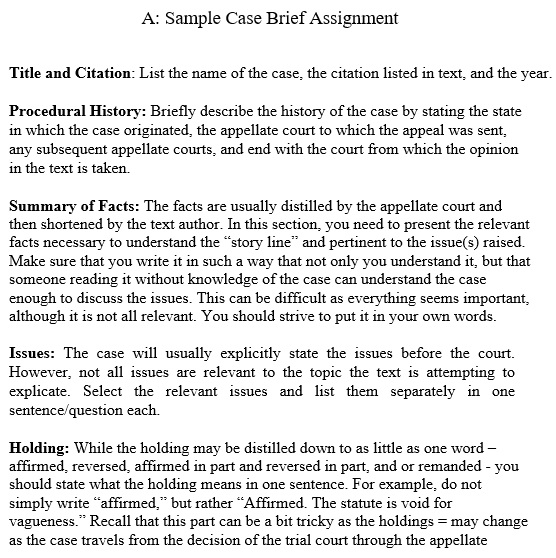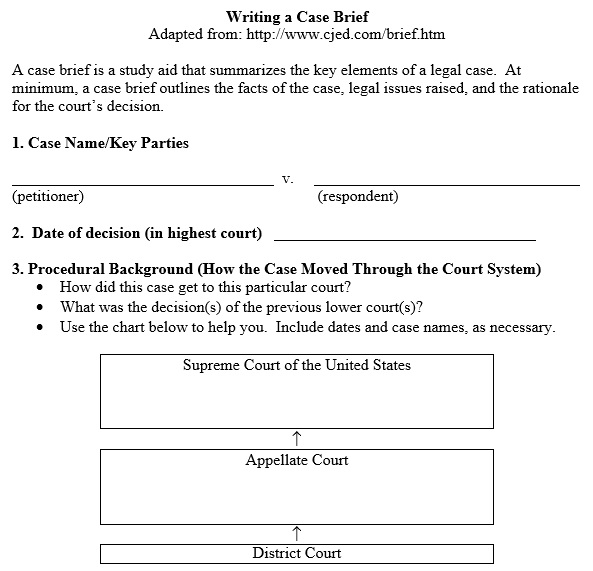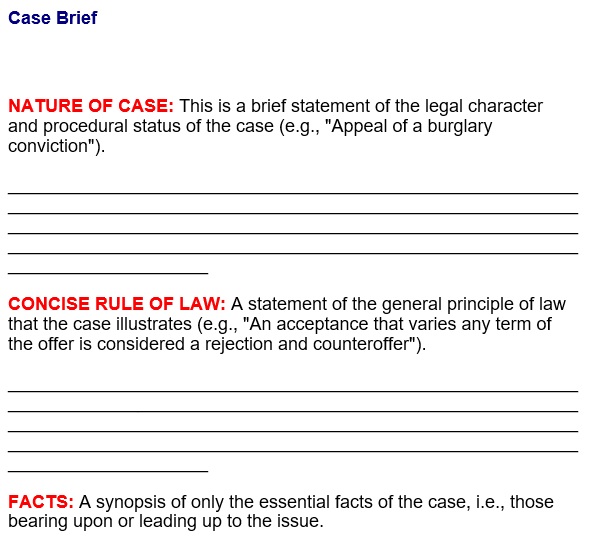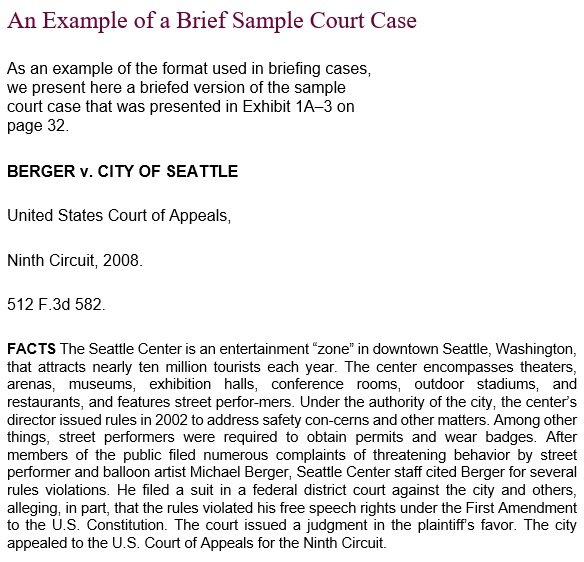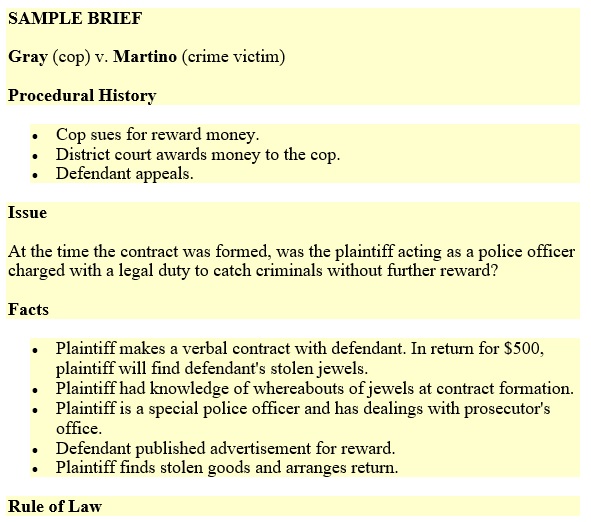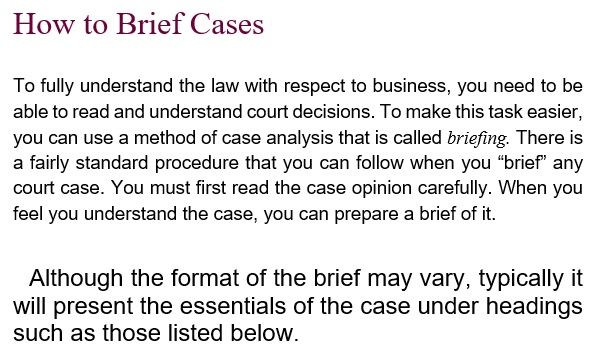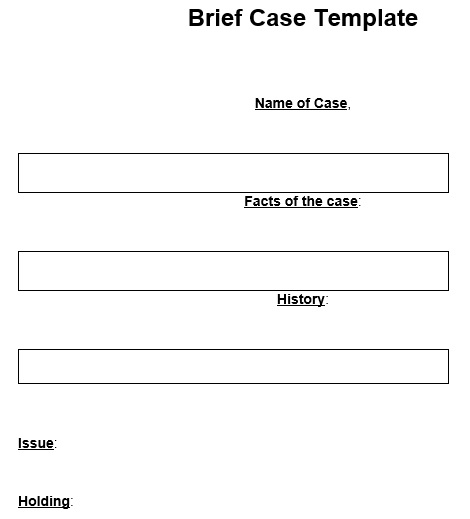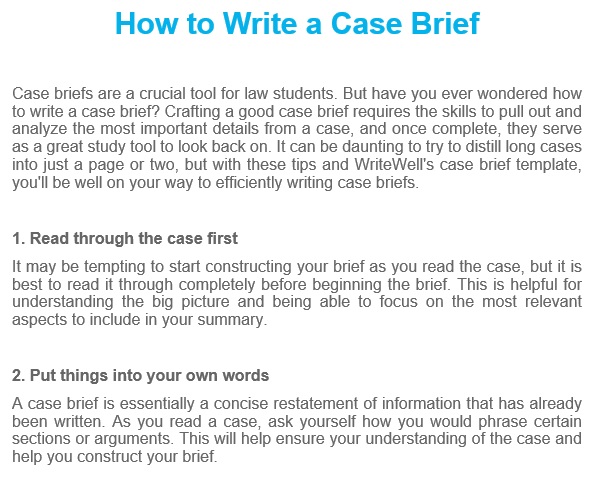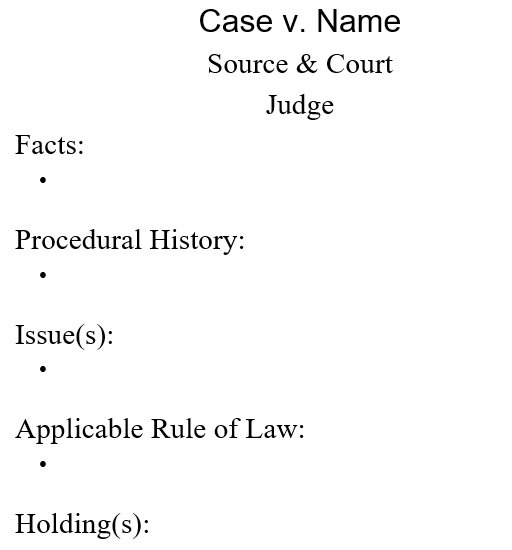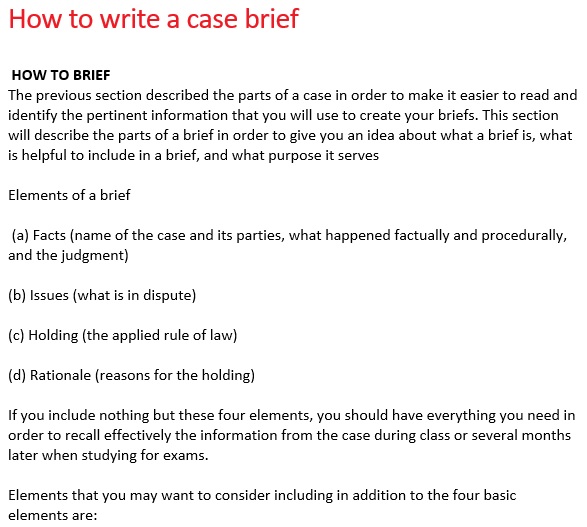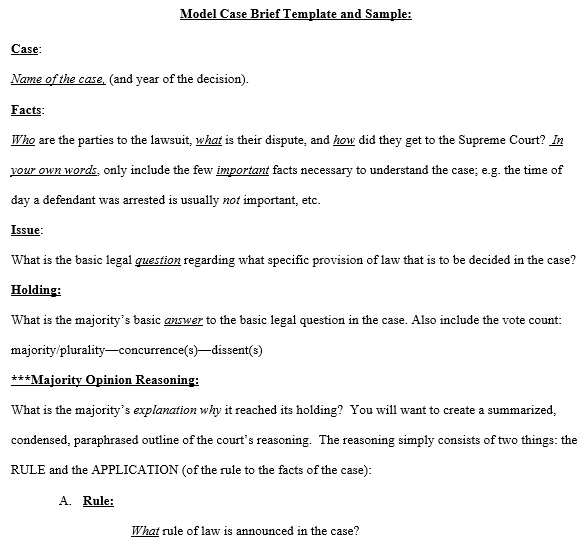A case brief template is a written document that contains shortened and concise summary of a court opinion. It is usually in outline form. This document is used for more efficient self-study. Instead of going through a verbatim case which is about 100 pages long, a well-written case brief is a lot easier to read. Since it is a lot simpler than the actual case file, you can also use it to display a case to other people.
Moreover, in order to make it effective and understandable, it should contain the following basic elements;
- In the case, the particular legal issue that is in question.
- The particular rule of the law which is to be applicable to the case.
- The court’s holding or conclusion.
It should be a precise summary that you have to be written in your own words. You would understand the case a lot more as you are paraphrasing by making your own case brief.
Table of Contents
Case briefs are for:
Typically, law students make and use it by using their own words. While creating, it is important to pay attention to the most important aspects. Let us take a look below at what case briefs are for;
For the class:
Law students use a sample case brief is in preparation for the class. In law school, different cases that are found in textbooks differ in length. So, it is important to select all the essential information from the cases and present them in a summarized and organized way. You should keep it brief in order to understand and process what you are reading about a case.
For legal writing and research:
For the purpose of legal writing and research, students make a brief in order to get all the key aspects and information. Almost all classes or course pays attention on this so you have to do a lot of practice making briefs for it. Moreover, brief cases help you in determining the most crucial information for you.
For outlining:
They are also essential to establish the foundation for further and more advanced studies. You should integrate all the information and then establish a better understanding of all the laws that are involved in the subject or the process called outlining.
Elements of a case brief:
The main elements of a case brief are;
Parties involved:
The first component is the parties that are involved in the case. You can determine the parties either by name or by the titles depending on their roles in the case. However, you can use both the names and the titles of the parties in order to make your brief more specific.
Court:
Include the court which had heard the case. Following are the different kinds of courts who can hear cases:
- State Court
- Federal Court
- Supreme Court
- Intermediate Appellate Court
Citation:
The citation should be included in your brief. This is the information which would state where the case was published. Adding this component allows the readers to easily find the original file for the case.
Date of the citation:
It is also important to include the date the case had been decided. This helps in tracing how legal issues have developed or evolved over time.
Procedural history:
This is the history of an entire case that contains;
- The name of the courts that the case was heard in.
- During previous court proceedings, all the events.
- At the most current court, how the case was arrived.
Issues:
You can use the table of contents, the section and chapter headings, case introductions and case notes to find the issues easily.
Facts:
Mention all the necessary facts and context facts in your case brief. Necessary facts are those which are legally essential. On the other hand, context facts are those which would assist you in understanding the necessary facts. Both kinds of facts have to be included in order to provide a clearer picture of an entire case.
Holding:
The legal questions that were asked in the case, this is answer to them. The question is “How did the court resolve all the issues?”
Reasoning:
This is the most important component and you can develop it by looking for the locations where the court is applying the law to the different facts. If you want to get a better understanding of everything you have read then use your own words during writing this part.
Judgment:
In the end, ensure to include the judgment made. As an outcome of the holding, this is what the court had done.
Some tips for law students to create a case brief:
- Firstly, understand you main argument. Along with a summary of entire case, place the purpose for writing a brief and then select the most essential points of it. This way, you can determine each and every aspect of the case and then you can easily figure out your argument.
- Create an entire paragraph regarding your argument and keep repeating it till you are happy with the result. You have to familiar with both sides of the case and ensure that you know all the details.
- Come up with different possible arguments in case you think it would be helpful. After that, select the best arguments and then add those in your brief. You should include only the most relevant and most important parts because you have to keep your brief precise.
- Include a persuasive and conversational story in your brief. Make use of an active instead of a passive voice while writing your brief.
How to write a case brief?
Here are some helpful tips that you should follow to write an effective brief case;
- At first, search for all the facts of the case and then create an outline of them. Facts are the most basic information that you require to make your brief.
- Everything such as procedures, dates, motions, rulings, verdicts, judgments, and so on that has happened in the case, make record of them.
- Place all the issues together in the case and present them in question form.
- The rule of law or principle used in the case, develop them. This would include the explained description that why the court had ruled the way it did.
- There is no need for too much time or effort while writing the concurring or dissenting opinion of the judge.
- You have to think about that how important the brief is to your class and why the brief is relevant to your course or your class.
- Write down all the questions you have about the case. This will help you in raising these questions when you are having discussions in class.
Mistakes to avoid while writing a case brief:
You should try to avoid following mistakes no matter whether you are writing a case brief or any other kind of legal document;
Don’t make use of a passive tone
It would be better to use an active voice rather using passive voice. When you use active voice in your writing, it indicates that you are writing the document on the basis of your own experiences by using your own words. Also, it leaves a stronger impact on your document.
Avoid using confusing pronouns
A confusing pronoun happens when in the same sentence, you refer the pronoun more than one person. The readers may get confused when you use such pronouns. In order to avoid confusion or misinterpretation, you should make sure while using such pronouns that they only refer to one person.
Check your Homophones
There are a lot of words that have different definitions but they sound the same. You have to be very careful while using them because these words are very common in legal documents.
Using verbs as nouns
Verbs and nouns are interchanged in legal writings which is a quite common mistake. When a verb is used as a noun then this is referred to as nominalization. This is not correct and often, it is unnecessary. Your writing gets improved if you avoid nominalizations.
Not proofreading
In creating any kind of document, proofreading is very important and final step. You may ignore or overlook common mistakes in spelling and grammar if you are writing a document for a long time.
Conclusion:
In conclusion, a case brief template is a reduced and summarized court opinion. Your case brief must include all the key elements and would have the main point of the court’s opinion. During writing your case brief, don’t write using a passive tone, avoid ambiguous pronouns, and check your homophones.
Faqs (Frequently Asked Questions)
The structure of legal brief and legal memorandum is same as well as their purpose but the audience that they’re written for are different. Legal memos summarize legal issues for clients, other legal professionals, or court officials while, legal briefs are exclusively court documents which you present to judges or other court officials.



